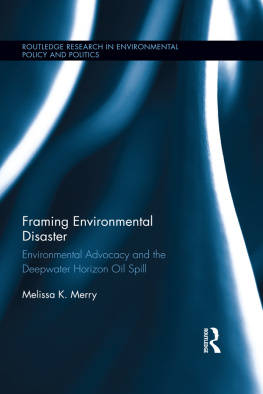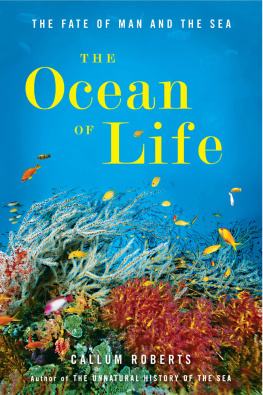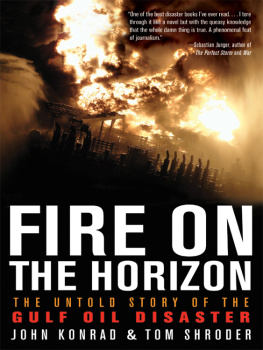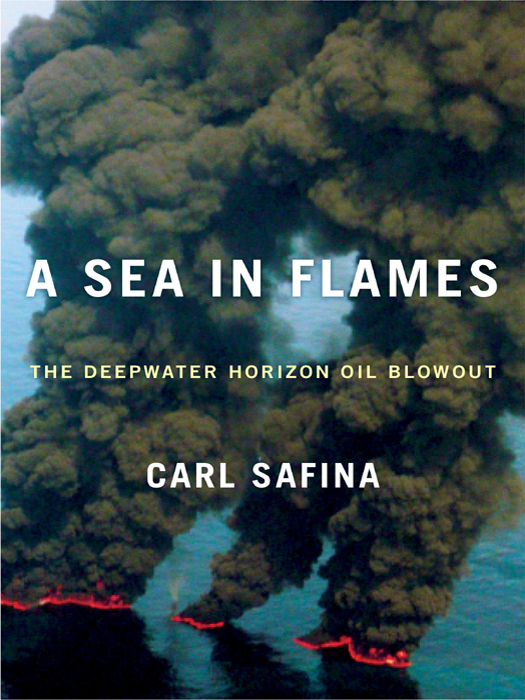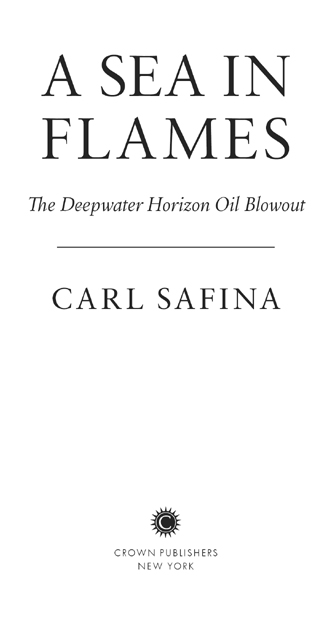ALSO BY CARL SAFINA
The View from Lazy Point
Nina Delmar: The Great Whale Rescue
Voyage of the Turtle
Eye of the Albatross
Song for a Blue Ocean
Copyright 2011 by Carl Safina
All rights reserved.
Published in the United States by Crown Publishers,
an imprint of the Crown Publishing Group,
a division of Random House, Inc., New York.
www.crownpublishing.com
CROWN and the Crown colophon are registered trademarks of Random House, Inc.
Library of Congress Cataloging-in-Publication Data
Safina, Carl, 1955
A sea in flames : the Deepwater Horizon oil blowout / Carl Safina.
p. cm.
1. BP Deepwater Horizon Explosion and Oil Spill, 2010Environmental aspects. 2. BP Deepwater Horizon Explosion and Oil Spill, 2010Social aspects. 3. Oil spillsMexico, Gulf of. I. Title.
GC1221.S24 2011
363.73820916364dc22 2010051455
eISBN: 978-0-307-88737-5
Jacket design by David Tran
Jacket photograph by U.S. Coast Guard/Getty Images
v3.1
To the memories of the people who died.
To their families.
To those who survived.
To the creatures that suffered.
To those who anguished.
To those who did their best.
And to those who continue asking what will come out of this well.
CONTENTS



Preface
Know Before You Go
C rucial mistakes, disastrous consequences, the weakness of power, unpreparedness and overreaction, the quiet dignity of everyday heroes. The 2010 Gulf of Mexico blowout brought more than oil to the surface.
This is not just a record of a technological event. Its also a chronicle of a season of anguish and panic, deep uncertainties, and the emotional topography of the blowout. It is the record of an event unfolding, a synthesis of personal experience, news, rumors, and the rapidly shifting perspectives about how bad things wereand how bad they were not.
There are roughly three parts to this event, and to this book: what caused this particular well to blow out; the varied technological, biological, and emotional responses during the months the oil was flowing; and a little more calmness, clarity, and insight after the flow of oil was stopped.
Ive chosen to convey my impressions as they occurred over a season that was intense, chaotic, and seemingly interminable. In the turmoil, it was easy to form the wrong impressions and follow blind alleys. And I did.
Over the months, information and understanding improved significantly. Later, after the flow of oil was stopped, we calmed down, and those with cooler heads began to see more clearly.
This book is not a definitive treatise; its a portrait. The story will continue unfurling. Some aspects, well never fully understand.
In trying my best to get it right, I am sure that nearly all of what Ive written is reasonable, most of it is true, and some of it is wrong. Its not less than that, and not more.
Its easy to criticize people in charge. Its much harder to be the person in charge. I was angry at the Coast Guard for weeks, until I began to realize that its ability to respond was largely dictated by the laws that confined it. If officials such as Admiral Thad Allen rankled me at times, it may say more about me than about them. But it remains part of the portrait of this whole event.
In truth, such people deserve not just our admiration but also a little slack. During the blowout, perfection wasnt an available option. Ive left my first impressions in place to show how my perceptions changed as my initial rageand I felt plenty of ragesubsided. Admiral Allen, as the most visible federal official and the man in charge, gets the brunt of my exasperation. But he never fully deserved it. I could not have done the job he did.
Admiral Allen, Dr. Jane Lubchenco, and others in our government gave us their very best under months of intense pressure, heavy responsibility, and public scrutiny. They were doing a nearly impossible job on behalf of us all. I didnt always appreciate that right away, especially during my summer travels through the Gulf region, when I was often both angry and grief-stricken. In truth, they deserve our thanks and praise.
But its not all about them. Its about us. We all contributed to this event, and were all trapped in the same situation. We all use too much gasoline and oil, because weve painted ourselves into a corner when it comes to energy.
For clarity I have lightly cleaned up or slightly condensed some of the verbatim testimony and quotes. Verbal exchanges during the hours leading up to and including the initial disaster on the drilling rig derive from recollections of those who endured that trauma. Because they are subject to the fog of crisis, some testimony conflicts; we may never know how to resolve those contradictory recollections.
In the end, this is a chronicle of a summer of painand hope. Hope that the full potential of this catastrophe would not materialize, hope that the harm done would heal faster than feared, and hope that even if we didnt suffer the absolute worst, wed still learn the big lesson here.
We may have gotten two out of three. Thats not good enough. Because: therell be a next time.
Carl Safina
Stony Brook, New York
November 2010
BLOWOUT!
A pril 20, 2010. Though a bit imprecise, the time, approximately 9:50 P.M ., marks the end of knowing much precisely. A floating machinery system roughly the size of a forty-story hotel has for months been drilling into the seafloor in the Gulf of Mexico. Its creators have named the drilling rig the Deepwater Horizon.
Oil giant BP has contracted the Deepwater Horizons owner, Transocean, and various companies and crews to drill deep into the seafloor forty-odd miles southeast of the Louisiana coast. The target has also been named: they call it the Macondo formation. The gamble is on a volume of crude oil Believed Profitable.


